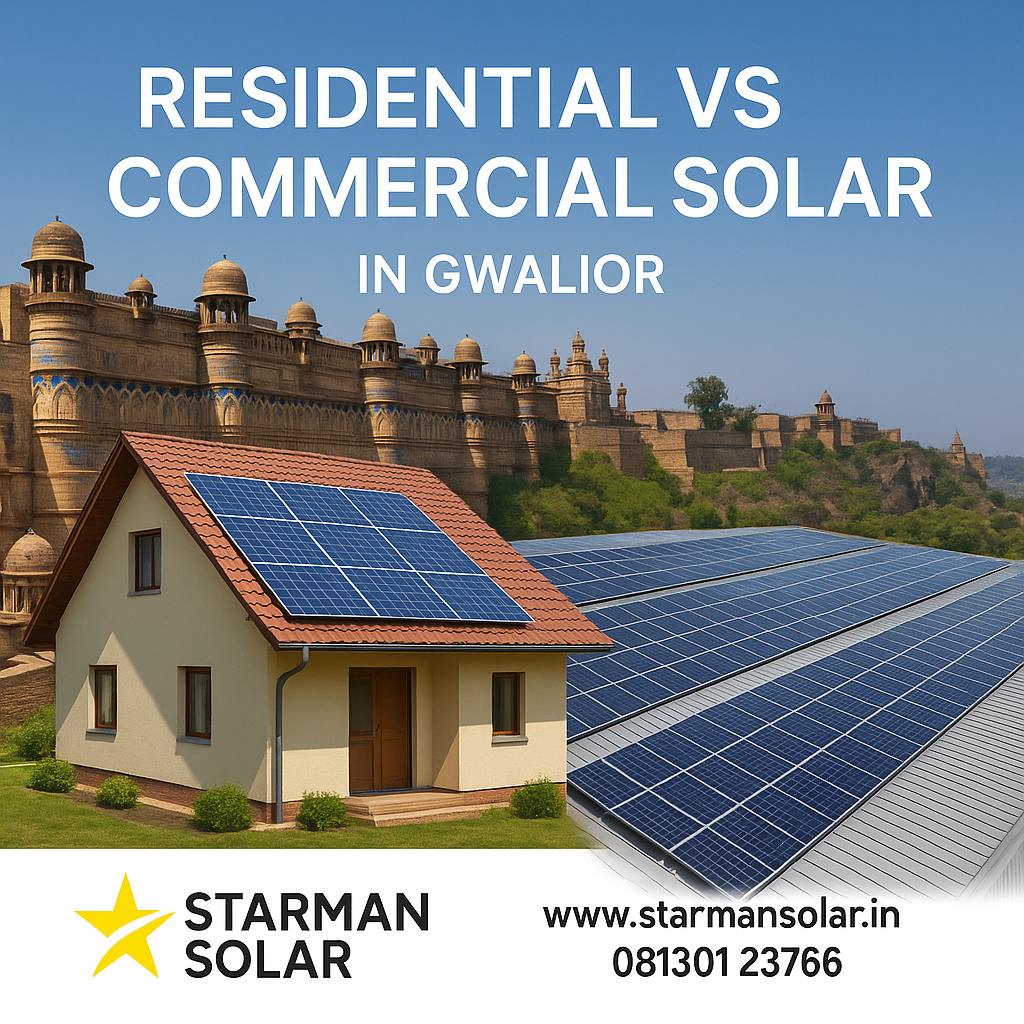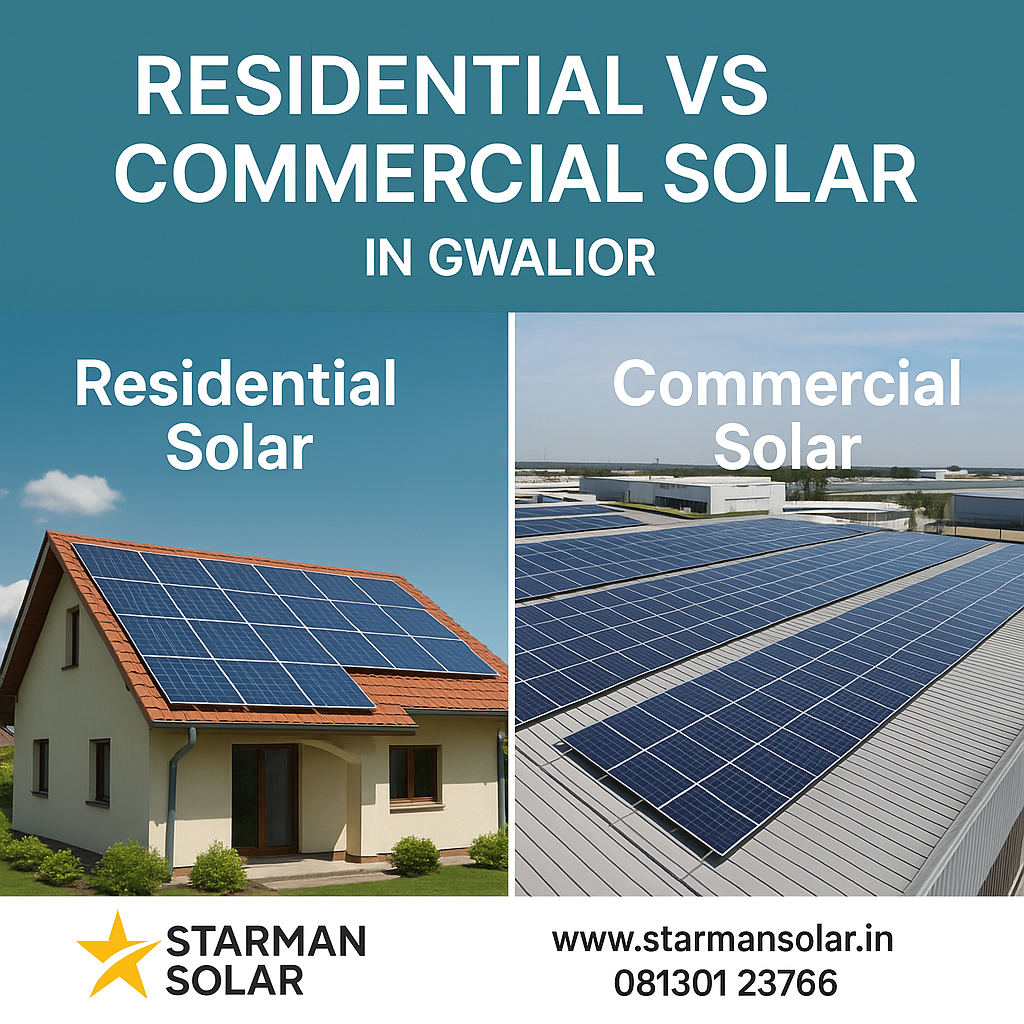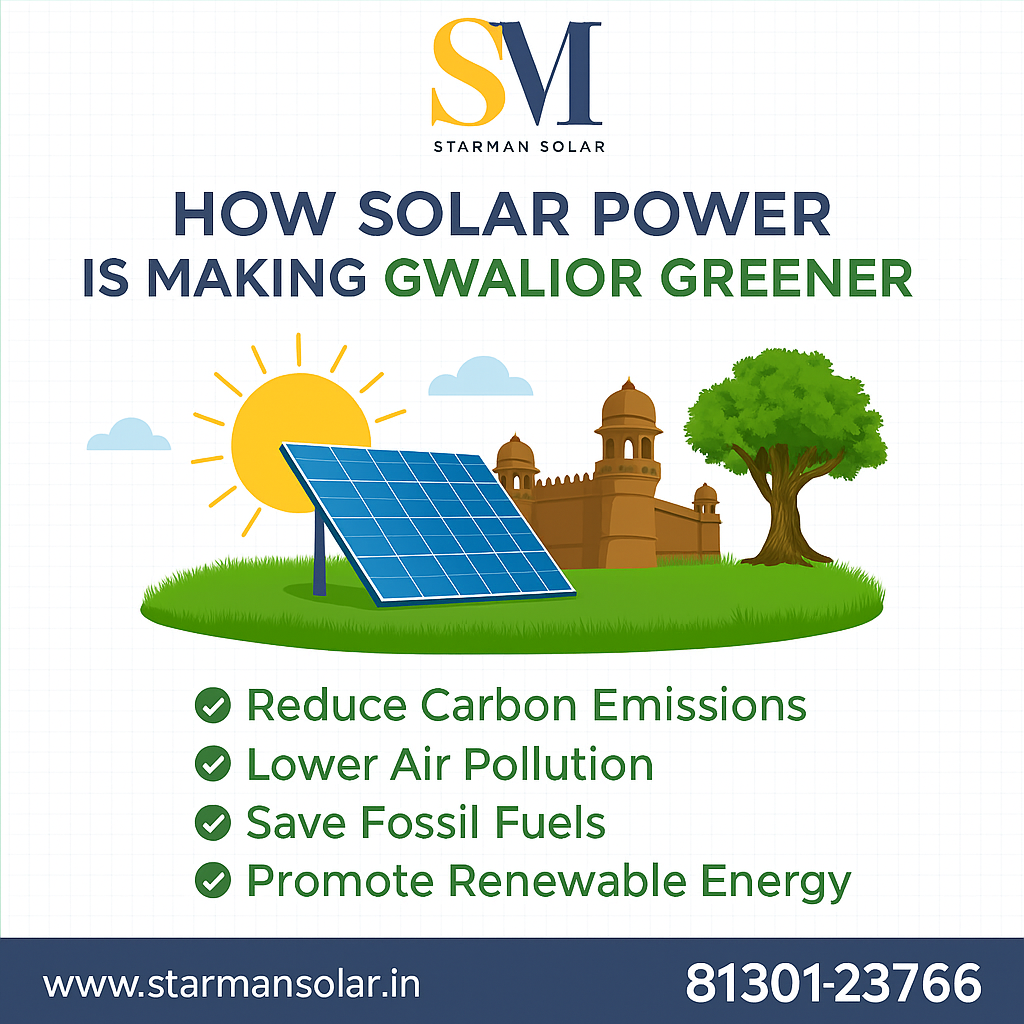Residential vs. Commercial Solar in Gwalior
- starman
- June 20, 2025
- 11:26 am
- No Comments


Gwalior, a historic city in Madhya Pradesh, is not just known for its forts and culture—it’s also becoming a growing hub for solar adoption. With rising electricity costs and increasing environmental awareness, both homeowners and businesses are turning to solar energy. However, choosing between residential vs. commercial solar in Gwalior involves understanding key differences in system design, cost, benefits, and installation.
This detailed guide by Starman Solar, a leading name in clean energy solutions, will help you differentiate between residential and commercial solar systems and make the right investment based on your needs.
Why Go Solar in Gwalior?
Gwalior receives over 300 sunny days annually, making it ideal for solar energy solutions. With the support of solar finance companies in India, government subsidies, and quality solar service providers like Starman Solar, adopting clean energy has never been easier.
Whether you’re a homeowner looking for a home solar energy set up company, or a factory owner seeking commercial-grade solar efficiency, understanding the right system is crucial.
Residential Solar Systems in Gwalior
What Are They?
Residential solar systems are designed for individual homes or apartments. These setups typically range from 1kW to 10kW and are ideal for reducing monthly electricity bills, especially in tier-2 cities like Gwalior.
Key Features
Smaller rooftop space requirements.
Net metering enabled.
Easy eligibility for government subsidies.
Installation time: 2–5 days.
Life span: 25 years+
Benefits
- Reduces electricity bills up to 90%.
- Increases property value.
- Environmentally sustainable.
- Easy to maintain with monitoring apps.
Starman Solar is recognized as a home solar energy set up company that provides complete solutions from survey to subsidy processing.
Commercial Solar Systems in Gwalior
What Are They?
Commercial solar systems are larger installations meant for factories, office buildings, educational institutions, and industries. These systems typically start from 10kW and can go up to 1MW or more depending on the load.
Key Features
Requires larger surface area (rooftop or ground).
High energy yield and ROI.
May not qualify for residential subsidies.
Eligible for accelerated depreciation under income tax.
Benefits
- Significant cost savings for high-consumption units.
- Supports CSR goals and green certification.
- Scalable for future expansion.
- Reduces reliance on grid power and diesel gensets.
Starman Solar, often regarded among the best solar installation company in India, offers full-scale commercial solar solutions, including engineering, procurement, installation, and maintenance.
Financing and Subsidy Options
In both cases, financing plays a major role in solar adoption. With the support of solar finance companies in India, users can opt for:
- EMI-based solar loans.
- Solar leasing options.
- RESCO (Renewable Energy Service Company) models for commercial clients.
Subsidies are generally more favorable for residential systems, while commercial projects benefit from tax incentives and bulk equipment discounts.
Role of Starman Solar in Gwalior’s Solar Revolution
As a trusted solar services website and on-ground installer, Starman Solar bridges the gap between quality systems and customer needs in Gwalior. From site surveys and customized solutions to post-installation maintenance, Starman Solar ensures:
MNRE-compliant installations.
Seamless net metering approvals.
Real-time energy monitoring.
Transparent pricing.
They also collaborate with top manufacturers and financial institutions, ensuring your investment is protected and optimized.
How Freenergy Solar and Starman Solar Compare
While Freenergy Solar is also active in India’s renewable sector, Starman Solar has localized expertise in Gwalior and offers end-to-end services, including government subsidy assistance. This makes it easier for residents and businesses to make informed solar investments without delays.
FAQs
1. What is the 20% rule for solar panels?
The 20% rule refers to sizing a solar system based on about 20% of the available roof area or 20% higher than the current energy consumption, to accommodate future needs or system losses.
2. What is the subsidy for solar panels in MP for commercial use?
There’s generally no direct central subsidy for commercial solar in MP. However, benefits include accelerated depreciation, GST input credit, and state-specific incentives. Residential customers can still avail up to 40% subsidy.
3. Which type of solar panel is best for commercial use?
For commercial installations, monocrystalline panels are preferred due to higher efficiency and space-saving advantages. Bifacial panels are also gaining popularity for industrial rooftops.
4. What is the cost of solar system in Gwalior?
- Residential (3kW): ₹1.5–₹2 lakh (after subsidy).
- Commercial (50kW): ₹20–₹25 lakh (depends on design and location).
These are indicative prices; Starman Solar provides detailed quotations after site surveys.
5. What is the 125% rule for solar panels?
The 125% rule suggests that the inverter capacity should be at least 125% of the expected solar generation load to avoid overloading and ensure efficient energy conversion, particularly in commercial setups.
Share:
starman
Related Posts

Founded in 2021, Starman Solar has emerged as a trusted name in renewable energy solutions in Gwalior.
Top Rated
Service 20255.0
CONtact WITH US
FOLLOW US
Starman Solar Pvt. Ltd. © 2025 All Rights Reserved | Designed By PR Digital Marketing



